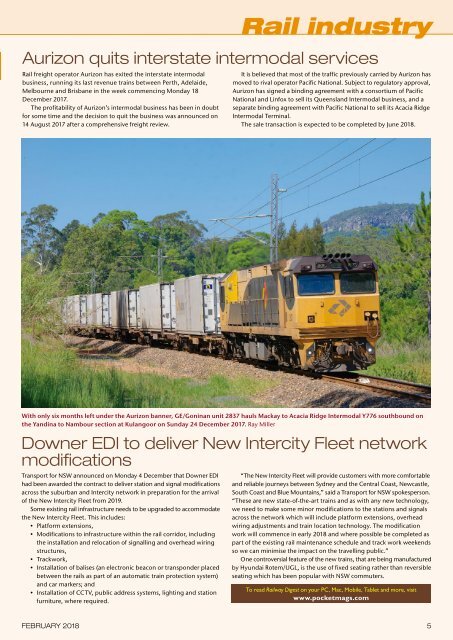Railway_Digest__February_2018
Create successful ePaper yourself
Turn your PDF publications into a flip-book with our unique Google optimized e-Paper software.
Rail industry<br />
Aurizon quits interstate intermodal services<br />
Rail freight operator Aurizon has exited the interstate intermodal<br />
business, running its last revenue trains between Perth, Adelaide,<br />
Melbourne and Brisbane in the week commencing Monday 18<br />
December 2017.<br />
The profitability of Aurizon’s intermodal business has been in doubt<br />
for some time and the decision to quit the business was announced on<br />
14 August 2017 after a comprehensive freight review.<br />
It is believed that most of the traffic previously carried by Aurizon has<br />
moved to rival operator Pacific National. Subject to regulatory approval,<br />
Aurizon has signed a binding agreement with a consortium of Pacific<br />
National and Linfox to sell its Queensland Intermodal business, and a<br />
separate binding agreement with Pacific National to sell its Acacia Ridge<br />
Intermodal Terminal.<br />
The sale transaction is expected to be completed by June <strong>2018</strong>.<br />
With only six months left under the Aurizon banner, GE/Goninan unit 2837 hauls Mackay to Acacia Ridge Intermodal Y776 southbound on<br />
the Yandina to Nambour section at Kulangoor on Sunday 24 December 2017. Ray Miller<br />
Downer EDI to deliver New Intercity Fleet network<br />
modifications<br />
Transport for NSW announced on Monday 4 December that Downer EDI<br />
had been awarded the contract to deliver station and signal modifications<br />
across the suburban and Intercity network in preparation for the arrival<br />
of the New Intercity Fleet from 2019.<br />
Some existing rail infrastructure needs to be upgraded to accommodate<br />
the New Intercity Fleet. This includes:<br />
• Platform extensions,<br />
• Modifications to infrastructure within the rail corridor, including<br />
the installation and relocation of signalling and overhead wiring<br />
structures,<br />
• Trackwork,<br />
• Installation of balises (an electronic beacon or transponder placed<br />
between the rails as part of an automatic train protection system)<br />
and car markers; and<br />
• Installation of CCTV, public address systems, lighting and station<br />
furniture, where required.<br />
“The New Intercity Fleet will provide customers with more comfortable<br />
and reliable journeys between Sydney and the Central Coast, Newcastle,<br />
South Coast and Blue Mountains,” said a Transport for NSW spokesperson.<br />
“These are new state-of-the-art trains and as with any new technology,<br />
we need to make some minor modifications to the stations and signals<br />
across the network which will include platform extensions, overhead<br />
wiring adjustments and train location technology. The modification<br />
work will commence in early <strong>2018</strong> and where possible be completed as<br />
part of the existing rail maintenance schedule and track work weekends<br />
so we can minimise the impact on the travelling public.”<br />
One controversial feature of the new trains, that are being manufactured<br />
by Hyundai Rotem/UGL, is the use of fixed seating rather than reversible<br />
seating which has been popular with NSW commuters.<br />
To read <strong>Railway</strong> <strong>Digest</strong> on your PC, Mac, Mobile, Tablet and more, visit<br />
www.pocketmags.com<br />
FEBRUARY <strong>2018</strong> 5


